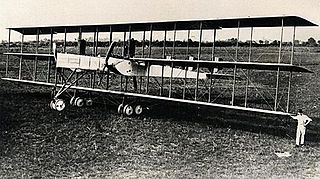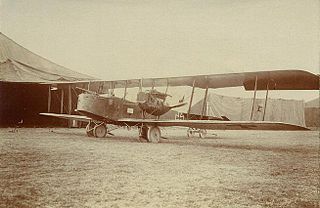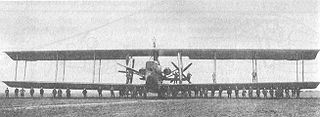
The Gotha G.V was a heavy bomber used by the Luftstreitkräfte during World War I. Designed for long-range service and built by Gothaer Waggonfabrik AG, the Gotha G.V was used principally as a night bomber.

The Caproni Ca.4 was an Italian heavy bomber of the World War I era.

The Zeppelin-Staaken R.VI was a four-engined German biplane strategic bomber of World War I, and the only Riesenflugzeug design built in any quantity.

The Friedrichshafen G.III was a heavy bomber designed and manufactured by Flugzeugbau Friedrichshafen. They were used by the German Imperial Air Service during World War I for tactical and limited strategic bombing operations. After the end of the war a number of Friedrichshafen bombers were converted into transport aircraft while a small number also saw service as dedicated airliners.

A Riesenflugzeug, sometimes colloquially referred to in English as an R-plane, was any member of a class of large World War I German bombers, possessing at least three aircraft engines, although usually four or more engines. These were large multi-engine aircraft capable of flying several hours with larger bomb loads than the smaller Grossflugzeug bombers such as the Gotha G.V.

The Mercedes D.IVa was a German six-cylinder, water-cooled, inline engine developed in 1917 for use in aircraft and built by Daimler Motoren Gesellschaft (DMG).

The Maybach Mb IVa was a water-cooled aircraft and airship straight-six engine developed in Germany during World War I by Maybach-Motorenbau GmbH, a subsidiary of Zeppelin. It was one of the world's first series-produced engines designed specifically for high-altitude use. It was quite different engine design than the previous Maybach Mb.IV, not just a simple modification.
The Gotha G.VII. a.k.a.GL.VII, was a bomber aircraft produced in Germany during the final months of World War I. With the strategic bombing campaign effectively over, it was intended to be a high-speed tactical bomber with a secondary reconnaissance capability. It was a conventional two-bay biplane design with tractor-mounted engines, and a conventional empennage with twin fins and rudders. The bombardier's position in the nose of the aircraft that had featured on earlier Gotha designs was removed, and the nose of the aircraft severely truncated and fitted with a streamlined nose-cone. This allowed the engines to be located further inboard than on previous designs, bringing them closer to the aircraft's centreline and therefore minimising the effects of asymmetric thrust in the event of an engine failure. The engine nacelles also featured careful streamlining.

The Siemens-Schuckert R.VIII was a bomber aircraft designed and built in Germany from 1916.

The Zeppelin-Staaken E-4/20 was a revolutionary four-engine all-metal passenger monoplane designed in 1917 by Adolf Rohrbach and completed in 1919 at the Zeppelin-Staaken works outside Berlin, Germany. The E-4/20 was the first four-engine, all-metal stressed skin heavier-than-air airliner built.

The Zeppelin-Staaken R.XVI(Av) was a very large bomber (Riesenflugzeug), designed and built in Germany during 1918.
The Zeppelin-Staaken R.XV was an Imperial German bomber of World War I. An incremental improvement to the Zeppelin-Staaken R.VI, this was one of a series of large strategic bombers called Riesenflugzeuge, intended to be less vulnerable than dirigibles in use at the time.
The Zeppelin-Staaken R.VII was six-engined large bomber - a Riesenflugzeug - of Imperial Germany, intended to be less vulnerable than the airships in use at the time.

The Zeppelin-Staaken R.V was one of a series of large bombers called Riesenflugzeugen, intended to be less vulnerable than the rigid airships in use at the time.
The Kawanishi K-7 Transport Seaplane was a Japanese single-engined biplane floatplane of the 1920s. Eleven were built from 1924 to 1927, being used to carry passengers and airmail.

The Zeppelin-Staaken Riesenflugzeuge were a series of very large bomber aircraft - Riesenflugzeuge, usually powered by four or more engines, designed and built in Germany from 1915 to 1919.
The Maybach Mb.IV, originally designated Maybach HS,, was a six cylinder in-line piston engine of 250 hp (190 kW) output, originally developed for use in airships. It was also used for large aircraft such as the Zeppelin-Lindau Rs.I giant seaplane.

The Zeppelin-Lindau Rs.II was a biplane flying boat, designed by Claudius Dornier as a follow-on to his Zeppelin-Lindau Rs.I and built during 1914–1915 on the German side of Lake Constance. Initially this aircraft was powered by three engines mounted inside the hull driving three pusher propellers via gearboxes and shafts. The later version was powered by four engines in two push-pull nacelles mounted between the wings.

Basse und Selve (BuS) were German manufacturers of engines for automobiles, motorcycles, boats, aircraft and railcars, supplying engines for Selve cars built at the Selve Automobilwerke AG, but also various other manufacturers of automobiles and commercial vehicles, such as Beckmann, Mannesmann, and Heim. The Altena factory was founded in 1908 by Gustav Selve, employing 2,000 workers, with Dr. Walther von Selve taking over the firm on the death of Gustav Selve, his father.

The Lloyd 40.08 Luftkreuzer was a three engine triplane bomber type built during World War I. The design was proven to be ineffective and development did not proceed past the prototype stage.
















